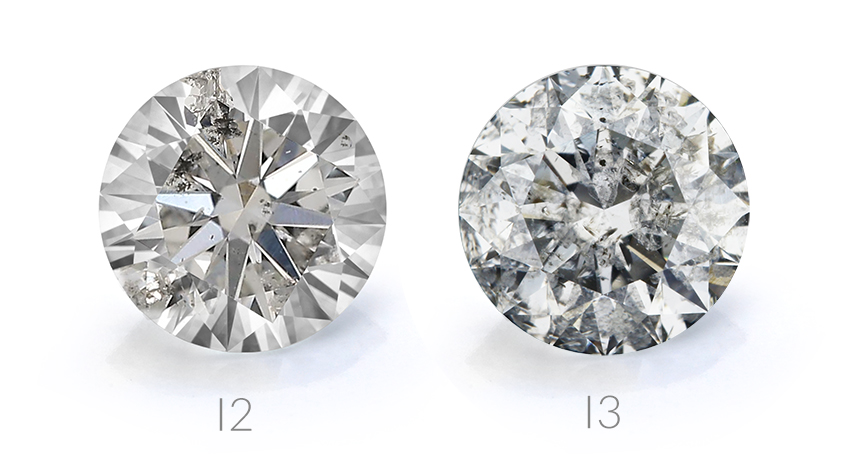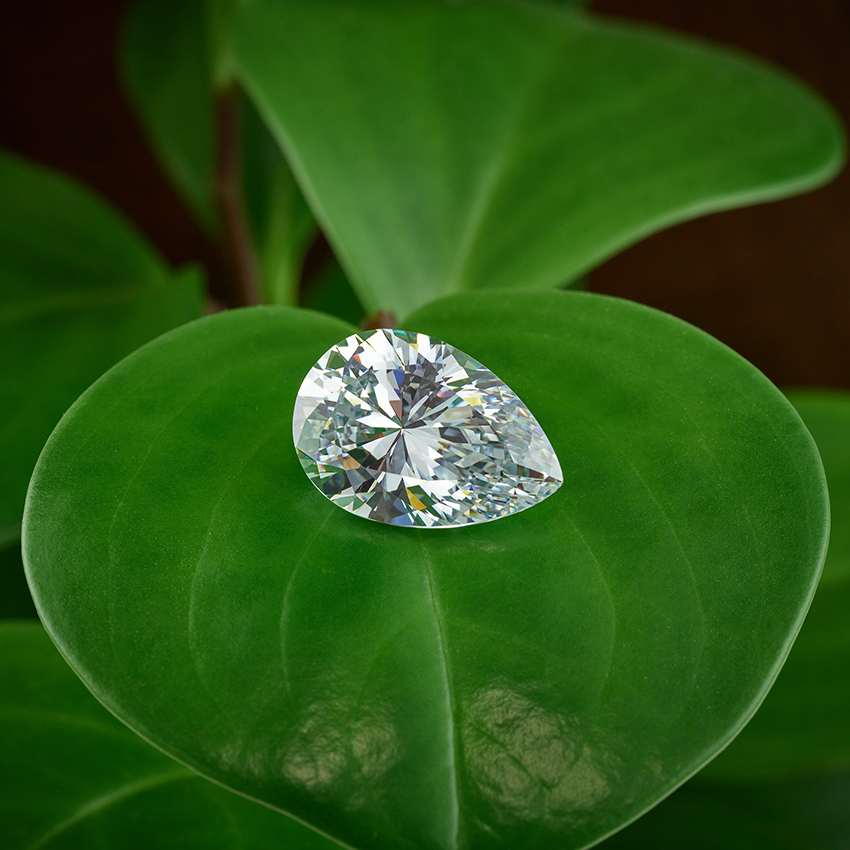What does I2 clarity mean?
I2 diamond clarity represents the second-lowest clarity grade available to diamonds. I2 stands between the I3 diamond clarity grade (lowest) and the I1 diamond clarity grade (better).
Diamonds graded I2 clarity feature noticeable inclusions, easily seen by the eye. At the same time, I2-clarity diamonds have more life and sparkle than lower-clarity I3 diamonds.

Diamond grading chart showing all of the diamond clarity grades available.
How does clarity affect a diamond?
In no uncertain terms, clarity affects the beauty of a diamond. Numerous inclusions reduce light passing through the stone. Many I2 clarity diamonds carry more risk of breakage or chipping, especially when inclusions break the surface of the diamond.
Some I2 diamonds feature distinctive marks within the diamond. Many such inclusions are more apparent due to their black colour. In contrast, white feathers make less impact.
Moreover, even dispersion of white inclusions makes more sense when choosing this clarity of the diamond. For this reason, we routinely photograph diamonds for clients unable to visit us. As a result, they form a much better appreciation for specific diamonds.
Lower-clarity diamonds often provide a way to lower the cost of any given item of jewellery. For example, in the case of diamond tennis chains. Or, when we make diamond line bracelets. Provided diamonds match for colour, clarity is not always a priority for some buyers.
How much do I2 diamonds cost?
Cost depends on three additional factors. The size, colour (whiteness) and cut of the diamond. But, as a guide, I2 clarity diamonds fetch far lower prices than better clarity diamonds. As a guide, expect to pay between £400 – £4000 based on 0.50 carats to 1.00 carats, respectively, for a decent whiteness with a very good cut grade.
Selecting a lower colour diamond of this grade reduces the cost even further. Reduce the cut grade, and prices fall significantly for the same size of the diamond.
From experience, clarity I2 colour HI works well together. H-I colour describes a commercial whiteness for diamonds, selected by many retailers. They are less expensive than whiter diamonds but lack the noticeable ‘yellow’ tinge associated with lower colour stones. H-I describes a midway assessment between both colour grades.
I2 and P2 diamond clarity grades
Many jewellers and diamond merchants refer to I (included) 2 diamonds as P2 clarity. This term means spotted or picked from the French word Piqué. Both terms mean the same thing.
I2 vs I3 clarity diamonds
If you’re unsure about the difference between I3 and I2 clarity, we’ve added a comparison below to show the difference. As you can see, the right (I3) diamond features a greater density of inclusions within the diamond. The additional inclusions reduce the passage of light through the diamond and diminish its brightness.

I2 and I3 clarity diamonds compared.
Where to purchase a diamond of this grade?
Despite our standard colour and clarity (G SI1) we source and supply all clarity grades, including I2 clarity. Please contact a member of our team for more help and guidance and a list of available diamonds.
Use our new diamond search tool to look for either natural or lab-grown diamonds.
We now supply a wide range of lab-grown diamonds in addition to natural diamonds. Lab-grown options cost approximately 60% less than natural diamonds of the same specifications. For this reason, consider lab-grown instead of a lower-clarity natural diamond for your budget.
Video example of an I2 diamond
I2 clarity natural diamonds vs lab-grown diamonds
Over the last few years, the demand for lab-grown diamonds has exploded.
Cost is one of the main factors.
Put simply, lab diamonds provide the same optical, physical and chemical properties as a natural diamond.
Lab-created diamonds offer an identical, non-mined-created alternative at a lesser cost. At the same time, buyers can benefit from a higher colour and clarity grade.
For example, a 1 carat D colour IF (Internally Flawless) lab-grown diamond currently costs around 50% less than a 1ct G colour I2 clarity natural diamond. Most importantly, the lab-grown alternative provides flawless beauty, unlike the included diamond.

Please contact us for a quote and comparison between each option, based on any of our jewellery designs.
About Mark Johnson
My name is Mark and I'm founder at Serendipity Diamonds. I have 30 years or experience in polished diamonds and jewellery. Today, I work with an expert team in our Isle of Wight jewellery showroom located in Ryde. Most of my work involves helping clients in our showroom, working on our two websites and photographing jewellery commissions.



